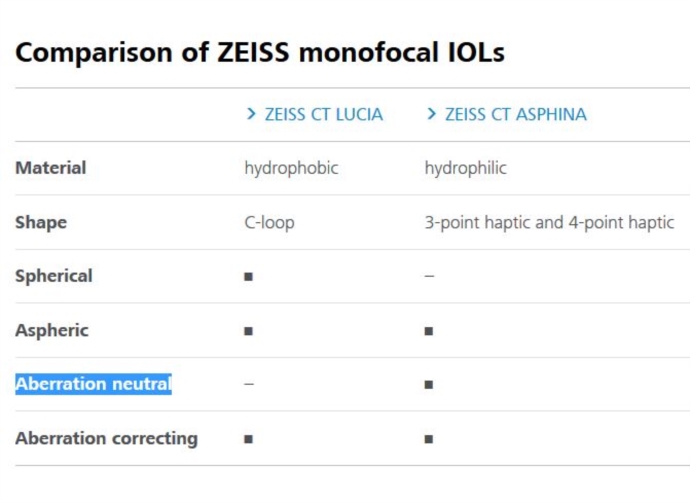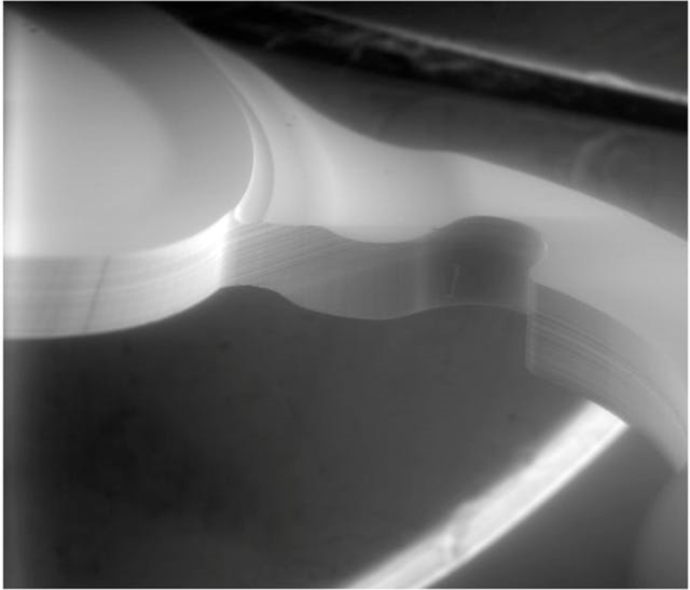Zeiss Monofocal IOLs Hydrophobic vs Hydrophobic surface properties!!! Any thoughts?
Posted , 5 users are following.
Based on the copy of the eye readings, it looks like our surgeon uses ZEISS CT ASPHINA 509 for Monofocal IOL. I shot him an email about ZEISS CT LUCIA.
My two issues with the Asphina lens are-
It is not 100% hydrophobic. Hydrophilic acrylate (25%) with hydrophobic surface properties (worried about glistening). The IOL will be used for few decades hopefully.
If it is Hydrophilic Acrylate 25%, what is the rest?
Does not have square edge design to minimize spread of PCO (wife is young so could end up being a mute point but still)
The ZEISS CT LUCIA has a sophisticated 3 μm radius sharp-edge design on the entire optic edge forming a barrier to prevent early cell migration and posterior capsular opacification (PCO)2. The proprietary lathe-cut manufacturing technology provides edge sharpness and integrity.
Step-vaulted haptics are designed to maximize direct capsular contact. The C-loop shape combined with the reinforced haptic optic junction, has been developed to provide easy centering and reliable refractive predictability for your patients. The ZEISS CT LUCIA is made with ultra-high-purity hydrophobic acrylic material and a proprietary cryo-lathing process – supporting glistening-free lens properties.1,3,4 As a results postoperative refractive outcomes are very stable and long-term optical clarity is provided.1-5
0 likes, 7 replies



Sue.An2 W-H
Posted
Neither of these lenses are available in Canada. Zeiss CT Lucia looks a lot like the Technis lenses. That design has the sharp edges to do more for pco prevention. For what it's worth I'd go for that lens. Will read up though to see if I can find anything helpful online.
Guest W-H
Posted
1/2. From what I have read, the hydrophilic acrylic 25% have 25% water content, the rest is acrylic material.
The hydrophilic acrylic gives very low incidence of glistening, the hydrophobic acrylic have had big glistening issues, Alcon are known for having glistening problems with their hydrophobic lenses for many years.
The hydrophilic acrylic also have very good light transmittance.
But hydrophilic acrylic is very slippery on the surface, and this makes it more prone to get misaligned and more prone to pco for some reason.
So they came up with this solution, to have the base material of hydrophilic acrylic with its good properties, and somehow make a coating of some sort of hydrophobic acrylic like material, to get the best of both worlds.
The latest in the field are the new types of claimed "glistening-free" hydrophobic acrylics, that it seems like Zeiss have taken a step into using as well, and off course it is easier for their production to only use one material than making 2 component iols.
3. I believe the backside of the iol is also square on the Aspina, it is only the center part where the light goes through that matters, so this Zeiss plate design have a ring around the center on the backside with square edge.
W-H Guest
Posted
I don't understand why does Zeiss have 2 types of monofocal IOLs called CT Lucia when the haptics are completely different?! So confusing!!! So the wire 3 piece ones and the 1 piece one which is the latest think.
Wire 3 piece ones called Lucia
The the presumend newere one piece one calle Lucia too!!!!***
W-H
Posted
Which does Zeiss consider their best monofocal Aspheric IOL?
One piece LUCIA or Plate haptic ASPHINA? Any way I can find the price to understand which is more expensive? Might give a hint?
W-H
Posted
So many typos lol
Guest W-H
Posted
Different haptics have different advantages and disadvantages, they require a little bit different implant techniques, and eyes are different from person to person, so it will vary what type is best for each person.
I am sure dr. Zeiss will use the new Lucia or the Aspina, whatever is the best fit for your wife´s eyes, I believe the 3 piece design is used in special situations only here in Europe.
l80876 W-H
Edited
Also of note is that Asphina is micro incision 1.8mm
Lucia is small incision 2.2mm minimum (depending on diopter chosen).
Both are available preloaded in their own
dedicated injectors.
However, Lucia 621 is their response to growing evidence of significantly lower PCO and lens calcification rates for well designed and carefully manufactured hydrophobic IOLs.